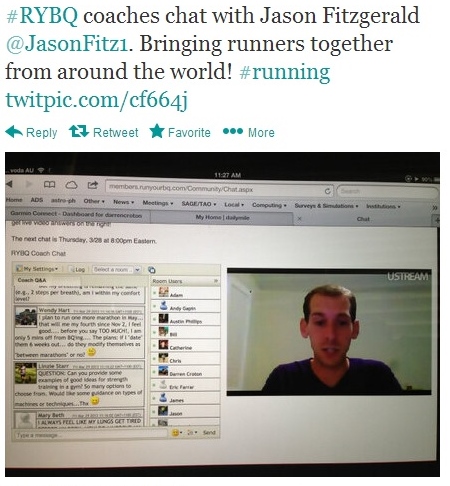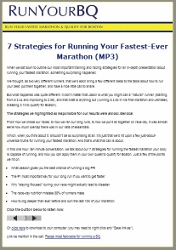Exercising and training are very different. Do you know how (and why it could be the difference between a huge personal best and another “so so” race)?

Exercising is for general health, well-being and even for fun. It makes you feel good. A few examples include fitness classes at the gym, recreational leagues like softball or kickball, and running casually a few times a week.
Training is quite different. It has a very specific purpose – like a goal time in a race – and therefore must be structured. It’s this structure that allows you to gain strength, speed, and endurance.
What I do as a coach is add the right structure to a person’s running so they’re training instead of exercising. A training plan from me introduces a specific series of workouts in a specific pattern that will progress over time.
This solves many problems that I see over and over:
- No variation in workouts and paces
- No long runs (or not enough of them)
- Poor pattern of weekly running workouts
- Only running with no “extras”
Often these changes have a profound impact on what a runner is capable of achieving on race day, whether they’re racing 5k or a marathon. Sometimes the mileage and workouts are similar, but when you get the PATTERN right, their performance on race day is significantly better.
I’ve been fortunate to have started my running career on a cross country team so I’ve always had this structure. It’s varied over time, but good training always follows the same general rules. After all, there are no shortcuts to success.
My USA Track & Field coaching education further influenced my views on periodization, training theory, multilateral training, and all of the principles of training design.
Yes, I am a training geek. I love this stuff.
And helping runners train rather than exercise (without burdening them with “Matveyev’s Model” and other jargon) is what I love doing. And it’s helped thousands of runners get faster and stay healthy.
So today, I want to show you how Bill used the Run Your BQ community to improve his marathon time against all odds and a slew of health concerns.
Fit… But Not Fast
There was no question about it: Bill was in good shape. He was putting in relatively high-mileage at 50+ miles per week and was able to clock a 4:08:59 marathon best in 2011.
He recognized that he had a strong endurance base but knew his weakness was his speed. He said:
“My previous training before RYBQ consisted mostly of running 50-60 MPW, but at a relatively slow pace for most of my runs. I ran the majority of my runs at the same pace, rarely varying the speed or workout intensity.
My goal for joining RYBQ was to gain additional training input from Jason and the others on the RYBQ forum. I was hoping to increase my speed in order to reduce my marathon time. I had a strong endurance base, but wanted to improve speed as well. “
Bill was good at exercising – but he certainly wasn’t training for the marathon. With no progression, “extras” or pace variation, he realized he needed outside help to improve on his marathon PR.
But after his 4:08 marathon, he experienced multiple health problems that derailed his training goals. While it’s hard enough to run a fast marathon, Bill had to handle more adversity than most of us.
First, he had foot surgery.
Then it got infected.
Then he got a stress fracture (in the same foot!).
Talk about every runner’s worst nightmare! Needless to say, Bill was not in an ideal position to start marathon training.
Nevertheless, he persevered…
Bill Started *Training* – and the results came quickly

Even though Bill was virtually starting from scratch when he joined Run Your BQ, he uploaded an appropriate training schedule from our library of plans and got to work.
Now he wasn’t exercising – he was training.
“My workouts changed after joining RYBQ by adding more speed into my workouts. What allowed me to add the speed workouts was the manner in which the RYBQ plans were structured. I was better able to run the faster workouts that were prescribed by the plans than I was when I followed other workout plans.
The RYBQ plans also added other workouts I was not receiving with other programs, such as hills, strides, and strength workouts.”
Bill was now doing some serious marathon training, but at an appropriate level for his ability and current fitness (this is why we have an entire library of training plans – so you can choose which one is right for you).
While workouts are important, it’s really the pattern of workouts, how they progress, and the overall training plan structure that will give you results and help you prevent injuries.
And unlike other generic training plans, I always include the “extras” that help runners stay healthy and ultimately race faster. So you’re never JUST getting running workouts. You’re getting a complete training system. Many coaches might shy away from sharing the specifics that help their athletes succeed (after all, it’s their secret sauce!), but I’ll tell you right now that Bill improved by:
- Adding more faster workouts to his week
- Running higher mileage
- Getting stronger with the right strength workouts
- Doing strides, flexibility work, and taking strategic rest days
I’m comfortable sharing all these details because you probably already know that these things will make you a better runner. But the pattern of workouts and structure of the plan are the real keys to succeeding.
These training elements not only help you prepare more completely for your race, but they help you believe that you can achieve your goals.
“The new workouts and the ability to be able to more easily finish the tempo runs were a very positive change in my workouts in building not only physical endurance but also increased my confidence that I could maintain higher speeds for longer periods of time.”
Can you imagine how that feels?
Being able to maintain a faster pace for a longer period of time – the very definition of endurance! Just what you’re looking for in a marathon program.
How Did Bill’s Next Marathon Go?
Throughout his training, Bill took advantage of our members-only forum and monthly Coach’s Chats (live video webinars) to guide his training. Whenever he had a question, he knew he could ask another marathoner or get his questions answered in real-time during our live Q&A sessions.
He told me:
I log on to the Coach’s Chats every time I can. I always pick up training tips from the questions of other runners and the feedback you provide. On one of the first chats I followed there was a good review of how best to run tempos; I tend to run them a little too fast, which reduces the distance I am able to run. The chats, as well as the forum, have reminders of proper training and even diet tips that are reinforced from hearing the experiences of other runners.
In between jokes about Kinesiotape and CrossFit, we get down to the business of helping our athletes through their training. So they can stay healthy, enjoy their running and race faster.

Note: we provide a walk-through video of the entire Run Your BQ site if you’d like to see what it looks like. Sign up here and I’ll send it to you soon.
When Bill’s training came to an end, it was finally time to run his next marathon.
And he ran a new personal best! Here’s how he described it:
“My new PR of 4:06:34 was an improvement over my prior 4:08:59, so the amount of time difference of around 2.5 minutes isn’t huge.
But my 4:08 was 2.5 years ago and since then I had foot surgery, which became infected, and then I developed a stress fracture in the same foot. So when I started the RYBQ plan I was not in good shape. Your plans not only got me back into better shape than I ever had been, they did so while helping to keep me, particularly my foot, injury free! Thanks!”
Bill’s improvement is particularly impressive because of his medical problems before he started training. Can you imagine getting surgery, an infection, and then a stress fracture… and following all that with a marathon PR? It blows my mind to hear about his success.
Since Run Your BQ includes membership for life, he knows he can use the many training plans to continue improving his marathon time. He’s already improved his speed and strength with the members-only programs, including strength workouts.
Finally, Bill had a few things to say about what he learned from RYBQ:
“The Run Your BQ community forums confirm that most runners have the same questions and offer answers during the course of training. It also has some great guidance on improving and maintaining your diet throughout training. It also offers great advice on carb-loading in the day or two before the marathon.
I was able to increase running strength from following the RYBQ plans and able to complete a higher level of speed workouts throughout the week. I was also able to run without injuries. I have suffered from stress fractures and strained tendons in my feet after and during other plans but was able to run injury free using RYBQ.
I would recommend RYBQ to other runners, for the primary reason that it worked! I was able to PR in my marathon on a day with 20-30 mph sustained headwinds during the final 7 miles, mostly due to the added strength I had gained from this program.”
Bill’s success – with not just his marathon PR but how he overcame his health issues and stress fracture – is motivation for all of us. Please join me in congratulating him on his shiny new personal best and thanking him for allowing me to share his story!
Sign up here for a free email series to help you become a better marathoner (we’ll also share with you when we open RYBQ) . You’ll get:
. You’ll get:
- 7 strategies to run your fastest marathon (podcast download)
- Sneak-peak RYBQ lessons
- Insider’s video of the entire site
- Case studies of successful marathoners so you can learn what helped them run their personal bests
- Running form advice
- Bonuses we don’t share publicly
- And much more – click here to learn more.